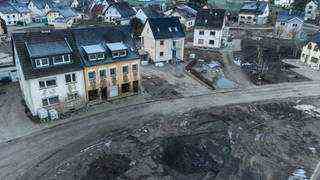The extent of the imminent flood disaster in the Ahr Valley should have been clear to the responsible authorities in good time. Several weather experts, including Jörg Kachelmann, made this clear in the investigative committee of the Rhineland-Palatinate state parliament.
According to Kachelmann’s conviction, the fatalities in the flood disaster in the Ahr valley could have been avoided. According to him, by the late morning of July 14, it was 100 percent clear that there would be a record flash flood in the Ahr Valley. At that time, record amounts of rain had already fallen on the upper reaches of the Ahr, to which the authorities had to react. According to Kachelmann, the people in the valleys should have been brought to safety.
Weather expert Jörg Kachelmann testifies in RLP’s Flood U Committee
dpa picture radio
picture alliance/dpa | Arne Dedert
Kachelmann: There is always enough time to do the right thing
The weather expert said: “A flood never comes suddenly.” But it takes many hours of rain. There is therefore always enough time to “do the right thing”. Nobody has to die if the right action is taken. According to Kachelmann, all weather models showed the high risk of extremely heavy rain for the Eifel several days in advance. The authorities could and should have planned evacuations and warned the population two days before the tsunami. The district of Ahrweiler only declared a disaster and ordered evacuations late in the evening of July 14.
Download video (11.9 MB | MP4)
The hydrologist Jörg Dietrich also reported that data had already shown on July 13 that there was an extreme risk of a flash flood on the upper Ahr. Based on these findings, the authorities could have decided on measures for the lower reaches of the Ahr on the afternoon of July 14, such as evacuations. The authorities would have misjudged the possible flood areas. There were then only specific warnings for people who lived 50 meters to the left and right of the Ahr.
“You should have known that 50 meters is far from enough,” said Dietrich. In some places, the river overflowed by up to 500 meters. According to his report, there were hours of time that day to get people to safety, at least on the lower reaches of the Ahr. In the afternoon, high levels were measured on the upper reaches of the Ahr. The tidal wave only reached Sinzig am Rhein seven hours later, where 12 residents of a home for the disabled died.

Flood U Committee in RLP interviews weather experts
dpa picture radio
picture alliance/dpa | Arne Dedert
The Karlsruhe graduate meteorologist Bernhard Mühr made a similar statement. According to his report, it was foreseeable on the morning of July 14 that extreme rain would hit the Ahr. Accordingly, by 4 p.m. at the latest, it was undoubtedly clear that there would be a flood of extreme proportions on the Ahr – and a flood that occurs less frequently than every 100 years. According to Mühr, steps should have been taken to protect the people by then at the latest. But that did not happen.

Deep Bernd has caused enormous damage in the Ahr valley. This is shown by the pictures from the first days after the disaster. This is what it looks like here today.
more…
Doubts whether the explosive nature of the warnings was recognizable
From the point of view of the expert Mühr, the German weather service (DWD) “warned early and factually correct”. The DWD issued the highest possible warning level 4 before continuous rain on July 13th. However, he doubts that the explosiveness and the pressure to act from the text of the DWD could be recognized by everyone. Mühr complained: “There are too many weather warnings in Germany.” There is a risk that the really important reports would be overlooked. The responsible authorities should have realized the pressure to act after the warning.

Reconstruction is underway in the areas in Rhineland-Palatinate that were destroyed by the flood disaster. Many of those affected have been living in emergency shelters for months. Here is the current situation:
more…
Plöger: “The problem is to limit warnings”
Meteorologist Sven Plöger reported: “What I knew on July 12 was that we had to expect a lot of rain,” said Plöger. It was clear: “Something is coming”. At this point he had already warned: “Watch out for the rivers, watch the levels, get away from the rivers”. “I did not know that the Ahr level would rise over nine meters, and I claim that nobody knew that either”. The problem lies in the specific limitation of the weather warnings. It is too difficult to predict with several days in advance exactly where such storms lead to devastating tidal waves like in the Ahr valley.

Meteorologist Sven Plöger before the U-Committee of the RLP state parliament on the flood
dpa picture radio
picture alliance/dpa | Arne Dedert
“Meteorologists cannot call for evacuations”
For July 14, the day of the Ahr Valley flood, there was also a risk of an extremely heavy rain event in the Black Forest, said Plöger: “Exactly nothing happened in the Black Forest, it just rained a lot.” He is convinced that regions affected by extremely heavy rain cannot be evacuated well in advance. According to Plöger, it is not the job of meteorologists to call for the evacuation of certain areas.
Cloke: “The death toll shows the system has failed”
The British scientist Hannah Cloke, who was connected live to the committee of inquiry, said that the European flood warning system EFAS had on 9/10. July for the Rhine catchment area with a very high probability of flooding from July 13 predicted. “A serious flood was imminent,” said the professor from the British University of Reading and freelance EFAS consultant. There was a warning of considerable severity and she was very surprised that so many people died in the flood disaster. “The death toll shows that the system has failed,” said Cloke. However, the criticism does not refer to specific parts of Rhineland-Palatinate. She did not know how the EFAS reports would be included in national and regional decision-making processes.

British scientist speaks to RLP-U committee on flood via video link
dpa picture radio
picture alliance/dpa | Arne Dedert
Geographer: Soils in the Ahr Valley hardly store any water
According to the geographer Heye Bogena from the Jülich Research Center, there is a flood event in the Ahr Valley on average every fourth year. The main reason is the subsoil of the Rhenish Slate Mountains with thick layers that have few cavities or pores and can therefore hardly store any water. Due to a lot of precipitation in June and July 2021, he assumes that the soil was already about 50 percent saturated on July 14, 2021 when the heavy rain started, says Bogena. That certainly aggravated the situation.

Within a few hours, small rivers in the Eifel have turned into torrential rivers. There are several reasons why the flood could become so catastrophic so quickly.
more…
According to its chairman, Martin Haller (SPD), the committee of inquiry will continue to deal with the role of the State Office for the Environment at the next meeting on February 4th. An exchange with the investigating public prosecutor’s office is planned for February 11 and, according to Haller, the role of the Federal Office for Civil Protection and Disaster Control will be discussed in the meeting a week later.

